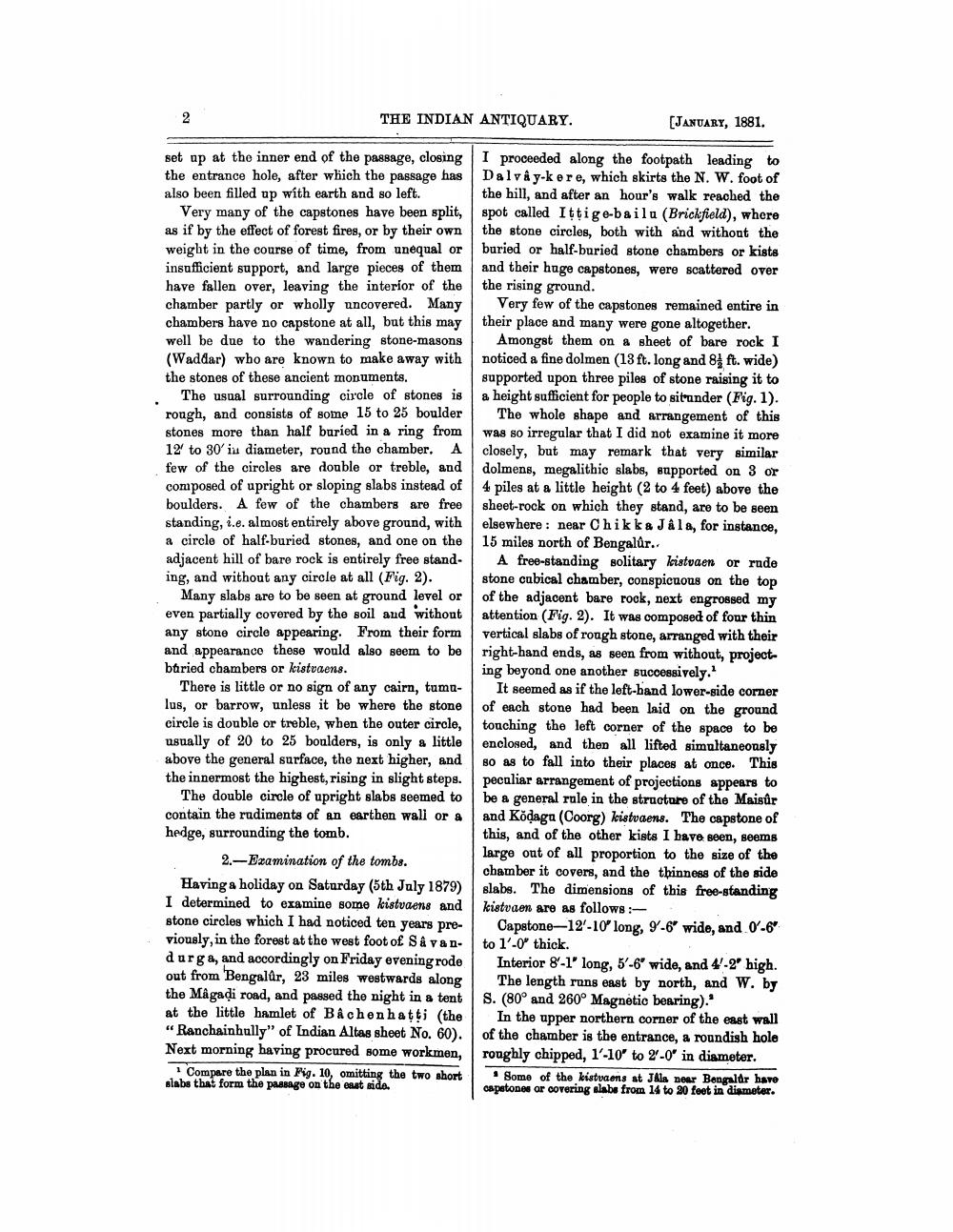Book Title: Indian Antiquary Vol 10 Author(s): Jas Burgess Publisher: Swati Publications View full book textPage 8
________________ THE INDIAN ANTIQUARY. (JANUARY, 1881. set up at the inner end of the passage, closing I proceeded along the footpath leading to the entrance hole, after which the passage hasDalvå y-kere, which skirts the N. W. foot of also been filled up wíth earth and so left. I the bill, and after an hour's walk reached the Very many of the capstones have been split, spot called Ittige-baila (Brickfield), where as if by the effect of forest fires, or by their own the stone circles, both with and without the weight in the course of time, from unequal or buried or half-buried stone chambers or kists insufficient support, and large pieces of them and their huge capstones, were scattered over have fallen over, leaving the interior of the the rising ground. chamber partly or wholly uncovered. Many Very few of the capstones remained entire in chambers have no capstone at all, but this may their place and many were gone altogether. well be due to the wandering stone-masons Amongst them on a sheet of bare rock I (Waddar) who are known to make away with noticed a fine dolmen (13ft. long and 84 ft. wide) the stones of these ancient monuments. supported upon three piles of stone raising it to The usual surrounding circle of stones is a height sufficient for people to situnder (Fig. 1). rough, and consists of some 15 to 25 boulder The whole shape and arrangement of this stones more than half buried in a ring from was so irregular that I did not examine it m 12 to 30' iu diameter, round the chamber. A closely, but may remark that very similar few of the circles are double or treble, and dolmens, megalithic slabs, supported on 3 or composed of upright or sloping slabs instead of 4 piles at a little height (2 to 4 feet) above the boulders. A few of the chambers are free sheet-rock on which they stand, are to be seen standing, i.e. almost entirely above ground, with elsewhere : near Chikk & Jala, for instance, a circle of half-buried stones, and one on the 15 miles north of Bengalûr. adjacent hill of bare rock is entirely free stand. A free-standing solitary keistvaen or rude ing, and without any circle at all (Fig. 2). stone cubical chamber, conspicuous on the top Many slabs are to be seen at ground level or of the adjacent bare rock, next engrossed my even partially covered by the soil and without attention (Fig. 2). It was composed of four thin any stone circle appearing. From their form vertical slabs of rough stone, arranged with their and appearance these would also seem to be right-hand ends, as seen from without, projectbtried chambers or kistraens. ing beyond one another successively." There is little or no sign of any cairn, tuma- It seemed as if the left-hand lower-side corner lus, or barrow, unless it be where the stone of each stone had been laid on the ground circle is double or treble, when the outer circle, touching the left corner of the space to be usually of 20 to 25 boulders, is only a little enclosed, and then all lifted simultaneously above the general surface, the next higher, and 80 as to fall into their places at once. This the innermost the highest, rising in slight steps. peculiar arrangement of projections appears to The double circle of upright slabs seemed to be a general role in the structure of the Maisur contain the rudiments of an earthen wall or a and Kõdaga (Coorg) kistvaens. The capstone of hedge, surrounding the tomb. this, and of the other kists I have seen, seems large out of all proportion to the size of the 2.-Examination of the tombs. chamber it covers, and the thinness of the side Having a holiday on Saturday (5th July 1879) slabs. The dimensions of this free-standing I determined to examine some kistvaens and kistvaen are as follows: stone circles which I had noticed ten years pre- Capstone-12-10' long, 9-6° wide, and 0-6' viously, in the forest at the west foot of Så van. to 1-0 thick. durga, and accordingly on Friday evening rode Interior 8-1' long, 5-6' wide, and 4/-2 high. out from 'Bengalur, 23 miles westwards along | The length runs east by north, and w. by the Magadi road, and passed the night in a tent S. (80° and 260° Magnetic bearing)." at the little hamlet of Bâchen hatti (the In the upper northern corner of the east wall "Ranchainhully" of Indian Altas sheet No. 60). of the chamber is the entrance, a roundish hole Next morning having procured some workmen, roughly chipped, 1-10 to 2-0 in diameter. Compare the plan in Fig. 10, omitting the two short Some of the kistuaons at JAls near Bangaldr have slabs that form the passage on the east side. capstones or covering slabe from 14 to 20 feet in diameter.Page Navigation
1 ... 6 7 8 9 10 11 12 13 14 15 16 17 18 19 20 21 22 23 24 25 26 27 28 29 30 31 32 33 34 35 36 37 38 39 40 41 42 43 44 45 46 47 48 49 50 51 52 53 54 55 56 57 58 59 60 61 62 63 64 65 66 67 68 69 70 71 72 73 74 75 76 77 78 79 80 81 82 ... 440
